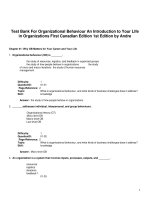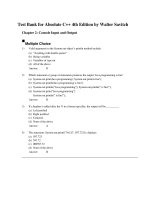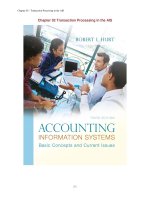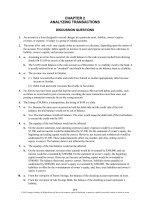Test bank and solution of an introduction to young uiwth special needs 4e (1)
Bạn đang xem bản rút gọn của tài liệu. Xem và tải ngay bản đầy đủ của tài liệu tại đây (336.16 KB, 5 trang )
Gargiulo/Kilgo, An Introduction to Young Children with Special Needs, 4th Edition
Chapter 2
The Context of Early Childhood Special Education
Learning Outcomes
After reading this chapter you will be able to:
• Define the terms disability, handicap, developmental delay, and at-risk.
• Discuss how judicial decisions and legislative enactments have benefited young
children with special needs.
• Summarize the major provisions contained in both PL 94-142 and PL 99-457.
• Identify at least four benefits of early intervention/education for young children with
special needs.
• Explain the concept of ecology and its importance to the field of early childhood special
education.
Key Terminology
Exceptional children
Disability
Handicap
Developmental delay
At-risk
Established risk
Biological risk
Environmental risk
Early intervention
Early childhood special education
Least restrictive environment (LRE)
Individualized education program (IEP)
Individualized family service plan (IFSP)
Meta-analysis
Ecology
Microsystems
Mesosystems
Exosystems
Macrosystem
Chronosystem
Copyright © 2014 Cengage Learning. All rights reserved.
Instructor’s Manual 2-2
Chapter Outline
I. Definitions and Terminology
A. Exceptional Children
1. Differ from societal or community standards of normalcy
2. Require early intervention or an educational program customized to their unique
needs
3. A young child with exceptionality is first and foremost a child.
B. Disability and Handicap
1. Disability and handicap often used interchangeably but they have distinct
meanings.
2. Disability is an inability of an individual to do something in a certain way.
3. Handicap refers to the problems that a young child with disability encounters as
she attempts to function and interact in her environment.
4. Today professionals only use the term handicap when explaining the
consequences or impact imposed on a young child by his or her disability.
C. Early Intervention and Early Childhood Special Education
1. Early intervention refers to the delivery of a coordinated and comprehensive set of
specialized supports and services to infants and toddlers (birth through age two).
2. Early childhood special education is typically used when talking about the
provision of customized services uniquely crafted to meet the individual needs of
young children three through eight years of age.
D. Developmental Delay and At-Risk
1. Adverse effects of early labeling
2. Recommended practices, Preschool labels for PL 99–457
3. Preschoolers do not have to be identified with one of thirteen federal labels.
4. IDEA allows for generic category, i.e., “children with disabilities.”
5. Programs serving young children with special needs use terms like
developmentally delayed and at-risk.
6. Developmental Delay.
a. A delay expressed in terms of standard deviation (SD)
b. A delay expressed in terms a of difference between child’s chronological
age and their actual performance
c. A delay expressed in terms of performance
d. Table 2-1 Representative Examples of Definitions of Developmental
Delay.
7. At-Risk
a. Children who have not been formally identified as having a disability, but
who may be developing conditions that will limit their success in school or
lead to disabilities.
b. Shachelford’s (2006) classify risk factors into three scheme: Established,
biological, and environmental.
c. Table 2-2 Representative Factors Placing Young Children At-Risk for
Developmental Problems
E. Federal Definition of Disability
Copyright © 2014 Cengage Learning. All rights reserved.
Instructor’s Manual 2-3
1. Individuals with Disabilities Education Improvement Act Amendment of 2004
(IDEA) (PL 108-446), defines a student with a disability according to thirteen
categories listed in Table 2-3.
II. Litigation and Legislation Affecting Children with Special Needs
A. Key Judicial Decisions
1. Table 2-4 A Synopsis of Selected Court Cases Influencing Special Education
B. Key Federal Legislation
1. Public Law 94-142: Bill of Rights for children with exceptionalities and their
Families
2. Public Law 99-457: Education of the Handicapped Act Amendments of 1986
•
Table 2-5 shows the year that each state mandated a free and appropriate
public education for preschoolers with disabilities.
•
Table 2-6 illustrates pre- and post- IDEA service delivery.
3. Public Law 101-476: Word “children” replaced with individuals and
“handicapped” became “with disabilities”
4. Public Law 102-119: Individuals with Disabilities Education Act Amendment
5. Public Law 105-17: IDEA reauthorized Individuals with Disabilities Education
Act Amendments of 1997.
6. Public Law 108-446- IDEA 2004 aligned the law with No Child Left Behind Act
(PL 107-110)
•
Individualized Education Program (IEP) Process
•
Identifying Students with Specific Learning Disabilities
•
Highly Qualified Special Education Teachers
•
Discipline
•
Due Process
•
Eligibility of Students
•
Assessment Participation
•
Services for Infants and Toddlers with Disabilities
7. Section 504 of the Rehabilitation Act of 1973: first public law specifically aimed
at protecting children and adults against discrimination due to a disability.
III. Prevalence of Young Children with Special Needs
A. Infants and Toddlers
1. Figure 2–1: Number of Infants and Toddlers Served Under IDEA in
Representative Years.
B. Preschoolers
1. Table 2-7 Increase in Numbers of Preschoolers Served under the Individuals with
Disabilities Education Act (Part B)
2. Figure 2–2: Percentage of Preschoolers Receiving a Special Education and
Related Services in the 2009-2010 School Year.
C. Early Primary
1. 8.3% of more thatn 1.20 million children ages six, seven, and eight are receiving a
special education during the 2009-2010 school year.
IV. The Importance of Early Intervention/Education
•
Quality early intervention/education programs do make a difference in the lives of
young children with disabilities and their families.
•
Table 2-8 Why Intervene Early?
Copyright © 2014 Cengage Learning. All rights reserved.
Instructor’s Manual 2-4
A. Representative Research Evidence on the Effectiveness of Intervention
•
Table 2-9 Beneficial Outcomes of High-Quality Preschool Programs
V. An Ecological Perspective on Young Children with Special Needs and Their Families
•
Children are influenced by environments (Brofenbrenner, 1977, 1979: ecology).
•
Influence of the classroom on the young child cannot be separated from influence
of family, community and culture.
•
Development grounded in the context in which it occurs (Brofenbrenner, 1979)
•
Nested relationships between children with special needs and their families
•
Value of the family seen in Head Start and IDEA
VI. Summary
VII. Check Your Understanding
VIII. Reflection and Application
IX. References
X. Making Connections
Discussion Topics, Class Activities, and Assignments
1. What is the difference between a disability and a handicap?
2. List the advantages of using the developmental delay category in early childhood special
education.
3. What is meant by the terms special education and related services?
4. Identify the significance of the following court cases:
a. Pennsylvania Association for Retarded Children v. Commonwealth of
Pennsylvania
b. Mills v. Board of Education of the District of Columbia
c. Larry P. v. Riles
d. Board of Education v. Rowley
5. List the major provisions of PL 94-142 and PL 99-457.
6. What is an individualized family service plan (IFSP)?
7. What is the role of a service coordinator?
8. Identify at least four benefits of early intervention/ education for young children with
disabilities and individuals considered to be at risk.
9. What general conclusions can be drawn from the efficacy research on early intervention?
10. According to Bronfenbrenner, how should early childhood special educators view young
children and their families?
Copyright © 2014 Cengage Learning. All rights reserved.
Instructor’s Manual 2-5
TeachSource Video Bonus Question
Foundations: Aligning Instruction with Federal Legislation
1. What is your opinion about the appropriateness of the No Child Left Behind Act for early
primary students with disabilities?
2. What is the relationship between IDEA 2004 and the No Child Left Behind Legislation?
Copyright © 2014 Cengage Learning. All rights reserved.









